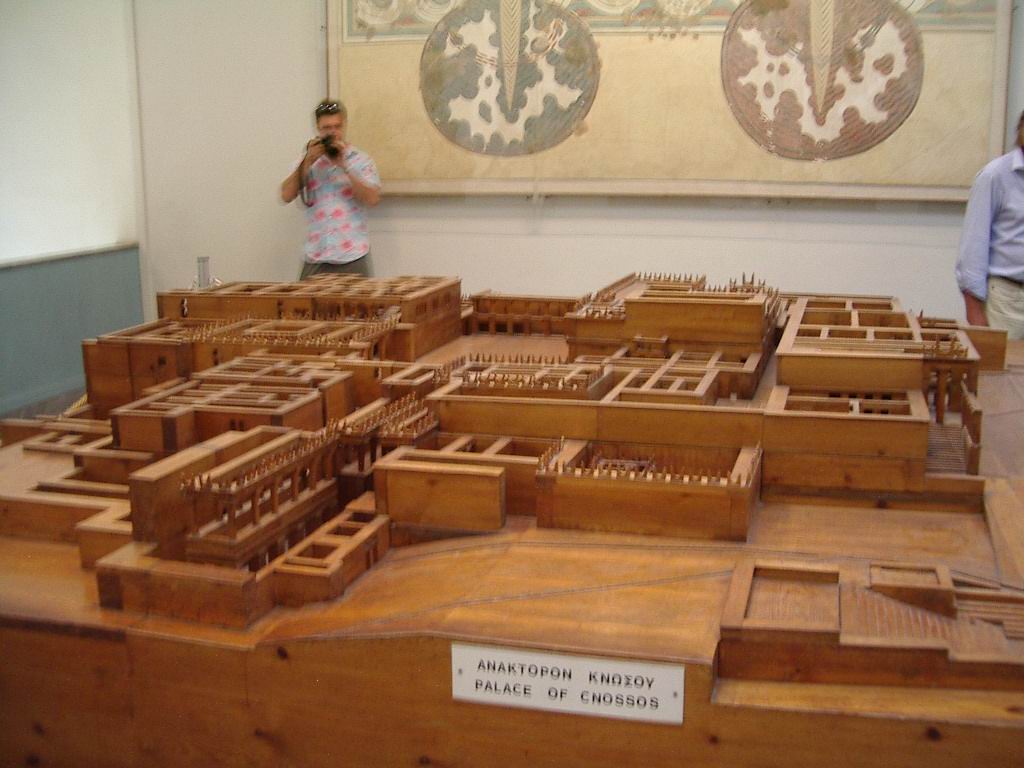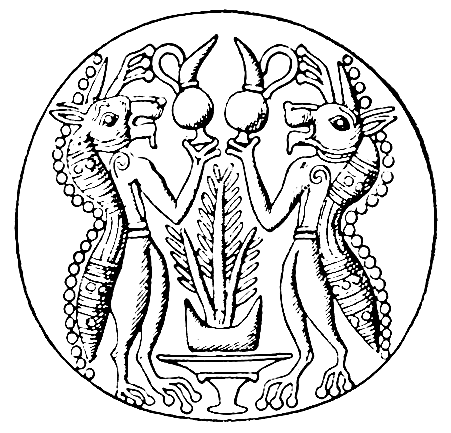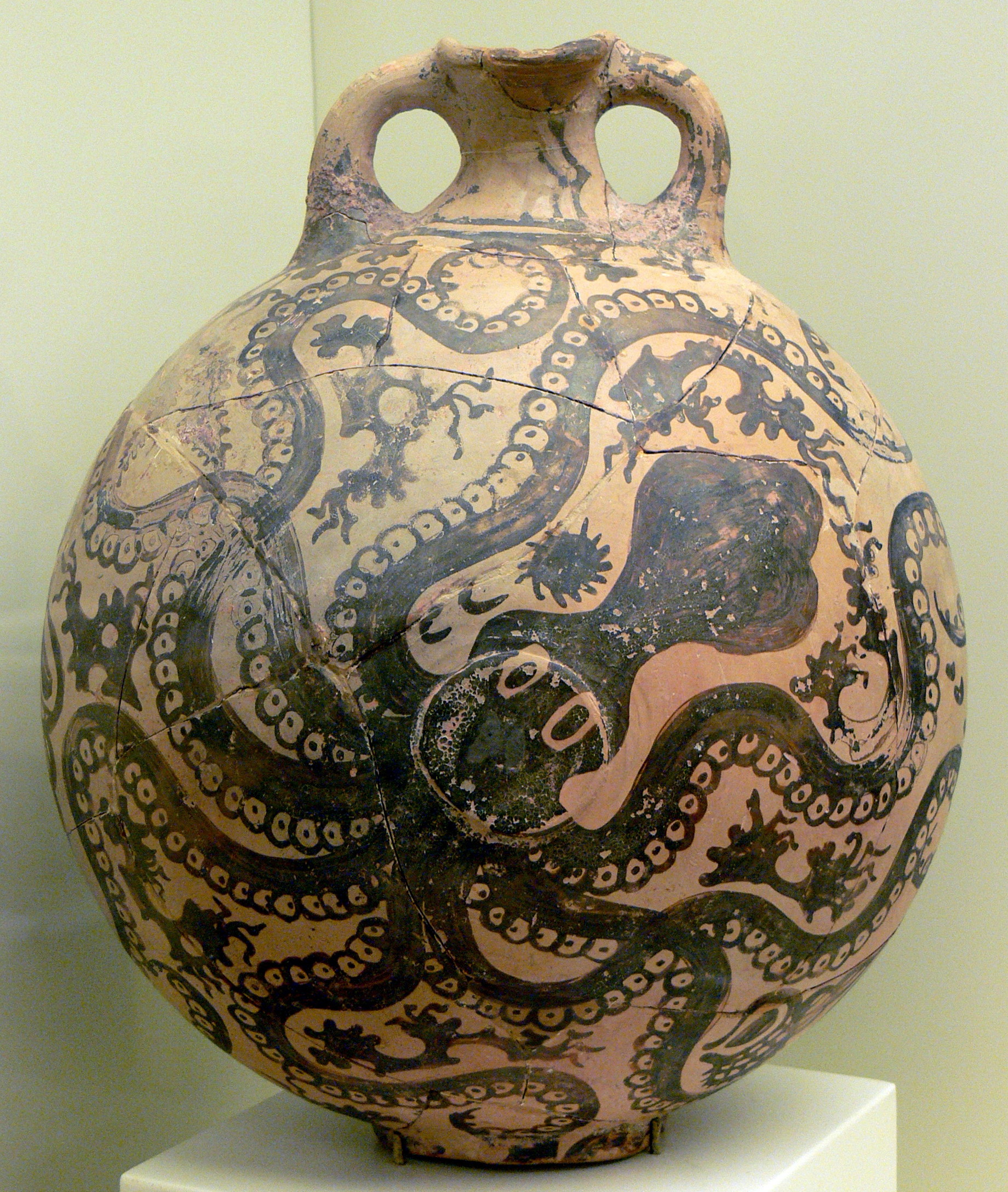|
Myrtos Pyrgos
Pyrgos (also Myrtos-Pyrgos; el, Πύργος (στο Μύρτος)) is an archaeological site of the Minoan civilization near Myrtos in the municipality of Ierapetra on the south coast of Crete. Pyrgos provides evidence of settlements along the southern Ierapetra Isthmus. This site has had a long history due to its valuable location and geography. It is located close to the Myrtos valley and has a harbor with a nearby mountain range providing its protection. The settlement includes a courtyard, many rooms, a country house and a tomb. History In 1970 the site began to be excavated by archaeologist Gerald Cadogan. It is near another Myrtos settlement called Fournou Korifi. This settlement lasted from the early Minoan period, middle Minoan period, and the Neopalatial period. The early Minoan Period lasted from 3560 BCE to 2160 BCE. The middle Minoan period includes the old and new palace period which lasted from 2160 BCE to 1600 BCE. The late Minoan period lasted from 1600 BCE ... [...More Info...] [...Related Items...] OR: [Wikipedia] [Google] [Baidu] |
Myrtos Pyrgos 74
Myrtos is a coastal village in the west of the municipality of Ierapetra, in the Regional Unit (previously called prefecture) of Lasithi on the Greek island of Crete. It is located from Agios Nikolaos and from Ierapetra, on the road to Viannos. A little to the west of the village is the iconic conical Kolektos mountain. Myrtos is situated on the Libyan Sea. The patron saint of the village is Saint Anthony. The population of the village in 2010 was approximately 600 people. The transliteral spelling of this village is often written as Mirtos. Myrtos has a rich history but has only prospered with the advent of tourism. The village has many tavernas and diverse shops for both residents and visitors. More recently there is now a pharmacy and an ATM. There are numerous churches, hotels, apartments and studios. There is a regular bus service between Ierapetra and Myrtos. History The area surrounding Myrtos was already inhabited during the Minoan period, but the current vi ... [...More Info...] [...Related Items...] OR: [Wikipedia] [Google] [Baidu] |
Shrine
A shrine ( la, scrinium "case or chest for books or papers"; Old French: ''escrin'' "box or case") is a sacred or holy sacred space, space dedicated to a specific deity, ancestor worship, ancestor, hero, martyr, saint, Daemon (mythology), daemon, or similar figure of respect, wherein they are veneration, venerated or worshipped. Shrines often contain Cult image, idols, relics, or other such objects associated with the figure being venerated. A shrine at which votive offerings are made is called an altar. Shrines are found in many of the world's religions, including Christianity, Islam, Hinduism, Buddhism, Chinese folk religion, Shinto, indigenous Philippine folk religions, and Germanic paganism, Asatru as well as in secular and non-religious settings such as a war memorial. Shrines can be found in various settings, such as Church (building), churches, temples, cemetery, cemeteries, Conservation of South Asian household shrines, museums, or in the home. However, portable shrine ... [...More Info...] [...Related Items...] OR: [Wikipedia] [Google] [Baidu] |
Populated Places In Ancient Greece
Population typically refers to the number of people in a single area, whether it be a city or town, region, country, continent, or the world. Governments typically quantify the size of the resident population within their jurisdiction using a census, a process of collecting, analysing, compiling, and publishing data regarding a population. Perspectives of various disciplines Social sciences In sociology and population geography, population refers to a group of human beings with some predefined criterion in common, such as location, race, ethnicity, nationality, or religion. Demography is a social science which entails the statistical study of populations. Ecology In ecology, a population is a group of organisms of the same species who inhabit the same particular geographical area and are capable of interbreeding. The area of a sexual population is the area where inter-breeding is possible between any pair within the area and more probable than cross-breeding with ind ... [...More Info...] [...Related Items...] OR: [Wikipedia] [Google] [Baidu] |
Minoan Sites In Crete
The Minoan civilization was a Bronze Age Aegean civilization on the island of Crete and other Aegean Islands, whose earliest beginnings were from 3500BC, with the complex urban civilization beginning around 2000BC, and then declining from 1450BC until it ended around 1100BC, during the early Greek Dark Ages, part of a wider bronze age collapse around the Mediterranean. It represents the first advanced civilization in Europe, leaving behind a number of massive building complexes, sophisticated art, and writing systems. Its economy benefited from a network of trade around much of the Mediterranean. The civilization was rediscovered at the beginning of the 20th century through the work of British archaeologist Sir Arthur Evans. The name "Minoan" derives from the mythical King Minos and was coined by Evans, who identified the site at Knossos with the labyrinth of the Minotaur. The Minoan civilization has been described as the earliest of its kind in Europe, and historian Will Dur ... [...More Info...] [...Related Items...] OR: [Wikipedia] [Google] [Baidu] |
Minoan Chronology
The Minoan chronology dating system is a measure of the phases of the Minoan civilization. Initially established as a relative dating system by English archaeologist Sir Arthur Evans between 1900 and 1903 based on his analysis of Minoan pottery during his excavations at Knossos on Crete, new technologies including carbon dating and DNA analysis have led to significant revisions to the date ranges. The Minoan Bronze Age period is divided into "Early Minoan" ("EM"), "Middle Minoan" ("MM"), and "Late Minoan" ("LM"), each sub-divided by Roman numerals I to III, and in many cases by a further "A" or "B," so, for example, "MM IIIB." In 1958 Nikolaos Platon proposed a new chronology at the Prehistoric Conference in Hamburg, based on the development of the architectural complexes known as "palaces" at Knossos, Phaistos, Malia, and Kato Zakros. In it, the terms "Pre-palace," "Old Palace," and "New Palace" were to replace Evans' scheme. The academic community accepted the scheme but not a ... [...More Info...] [...Related Items...] OR: [Wikipedia] [Google] [Baidu] |
Minoan Religion
Minoan religion was the religion of the Bronze Age Minoan civilization of Crete. In the absence of readable texts from most of the period, modern scholars have reconstructed it almost totally on the basis of archaeological evidence of such as Minoan paintings, statuettes, vessels for rituals and seals and rings. Minoan religion is considered to have been closely related to Near Eastern ancient religions, and its central deity is generally agreed to have been a goddess, although a number of deities are now generally thought to have been worshipped. Prominent Minoan sacred symbols include the bull and the horns of consecration, the labrys double-headed axe, and possibly the serpent. The old view was that, in stark contrast to contemporary cultures in Egypt, Mesopotamia and Syria, Minoan religious practice was not centred around massive formal public temples. However, it now tends to be thought that the Minoan "palaces" and perhaps also the smaller "villas", were themselves th ... [...More Info...] [...Related Items...] OR: [Wikipedia] [Google] [Baidu] |
Ranellidae
The Ranellidae, common name the triton shells or tritons, are a taxonomic family of small to very large predatory sea snails, marine gastropod mollusks in the order Littorinimorpha. Subfamilies According to the taxonomy of the Gastropoda by Bouchet & Rocroi, 2005, the family Ranellidae consisted of two subfamilies: *Ranellinae Gray, 1854 - synonyms: Agrobuccininae Kilias, 1973; Simpulidae Dautzenberg, 1900; Gyrineinae Higo & Goto, 1993 (n.a.) *Cymatiinae Iredale, 1913 (1854) - synonyms: Tritoniidae H. Adams & A. Adams, 1853 (inv.); Neptunellinae Gray, 1854; Lampusiidae Newton, 1891; Lotoriidae Harris, 1897; Septidae Dall & Simpson, 1901; Aquillidae Pilsbry, 1904; Nyctilochidae Dall, 1912; Charoniinae Powell, 1933 The Cymatiinae now form a separate family: Cymatiidae. Genera The family Ranellidae contains the following genera: * ''Haurokoa'' C. A. Fleming, 1955 † * ''Obscuranella'' Kantor & Harasewych, 2000 * ''Priene'' H. Adams & A. Adams, 1858 * ''Ranella ''Ranella'' is ... [...More Info...] [...Related Items...] OR: [Wikipedia] [Google] [Baidu] |
Minoan Pottery
Minoan pottery has been used as a tool for dating the mute Minoan civilization. Its restless sequence of quirky maturing artistic styles reveals something of Minoan patrons' pleasure in novelty while they assist archaeologists in assigning relative dates to the strata of their sites. Pots that contained oils and ointments, exported from 18th century BC Crete, have been found at sites through the Aegean islands and mainland Greece, on Cyprus, along coastal Syria and in Egypt, showing the wide trading contacts of the Minoans. The pottery consists of vessels of various shapes, which as with other types of Ancient Greek pottery may be collectively referred to as "vases", and also "terracottas", small ceramic figurines, models of buildings and some other types. Some pieces, especially the cups of rhyton shape, overlap the two categories, being both vessels for liquids but essentially sculptural objects. Several pottery shapes, especially the rhyton cup, were also produced in soft st ... [...More Info...] [...Related Items...] OR: [Wikipedia] [Google] [Baidu] |
Myrtos Pyrgos 07
Myrtos is a coastal village in the west of the municipality of Ierapetra, in the Regional Unit (previously called prefecture) of Lasithi on the Greek island of Crete. It is located from Agios Nikolaos and from Ierapetra, on the road to Viannos. A little to the west of the village is the iconic conical Kolektos mountain. Myrtos is situated on the Libyan Sea. The patron saint of the village is Saint Anthony. The population of the village in 2010 was approximately 600 people. The transliteral spelling of this village is often written as Mirtos. Myrtos has a rich history but has only prospered with the advent of tourism. The village has many tavernas and diverse shops for both residents and visitors. More recently there is now a pharmacy and an ATM. There are numerous churches, hotels, apartments and studios. There is a regular bus service between Ierapetra and Myrtos. History The area surrounding Myrtos was already inhabited during the Minoan period, but the current vi ... [...More Info...] [...Related Items...] OR: [Wikipedia] [Google] [Baidu] |
Myrtos Pyrgos 40
Myrtos is a coastal village in the west of the municipality of Ierapetra, in the Regional Unit (previously called prefecture) of Lasithi on the Greek island of Crete. It is located from Agios Nikolaos and from Ierapetra, on the road to Viannos. A little to the west of the village is the iconic conical Kolektos mountain. Myrtos is situated on the Libyan Sea. The patron saint of the village is Saint Anthony. The population of the village in 2010 was approximately 600 people. The transliteral spelling of this village is often written as Mirtos. Myrtos has a rich history but has only prospered with the advent of tourism. The village has many tavernas and diverse shops for both residents and visitors. More recently there is now a pharmacy and an ATM. There are numerous churches, hotels, apartments and studios. There is a regular bus service between Ierapetra and Myrtos. History The area surrounding Myrtos was already inhabited during the Minoan period, but the current vi ... [...More Info...] [...Related Items...] OR: [Wikipedia] [Google] [Baidu] |
Minoan Civilization
The Minoan civilization was a Bronze Age Aegean civilization on the island of Crete and other Aegean Islands, whose earliest beginnings were from 3500BC, with the complex urban civilization beginning around 2000BC, and then declining from 1450BC until it ended around 1100BC, during the early Greek Dark Ages, part of a wider bronze age collapse around the Mediterranean. It represents the first advanced civilization in Europe, leaving behind a number of massive building complexes, Minoan art, sophisticated art, and writing systems. Its economy benefited from a network of trade around much of the Mediterranean. The civilization was rediscovered at the beginning of the 20th century through the work of British archaeologist Sir Arthur Evans. The name "Minoan" derives from the mythical Minos, King Minos and was coined by Evans, who identified the site at Knossos with the labyrinth of the Minotaur. The Minoan civilization has been described as the earliest of its kind in Europe, and his ... [...More Info...] [...Related Items...] OR: [Wikipedia] [Google] [Baidu] |
Iconography
Iconography, as a branch of art history, studies the identification, description and interpretation of the content of images: the subjects depicted, the particular compositions and details used to do so, and other elements that are distinct from artistic style. The word ''iconography'' comes from the Greek ("image") and ("to write" or ''to draw''). A secondary meaning (based on a non-standard translation of the Greek and Russian equivalent terms) is the production or study of the religious images, called "icons", in the Byzantine and Orthodox Christian tradition (see Icon). This usage is mostly found in works translated from languages such as Greek or Russian, with the correct term being "icon painting". In art history, "an iconography" may also mean a particular depiction of a subject in terms of the content of the image, such as the number of figures used, their placing and gestures. The term is also used in many academic fields other than art history, for example semiotics ... [...More Info...] [...Related Items...] OR: [Wikipedia] [Google] [Baidu] |




.jpg)



